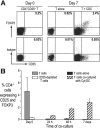Expansion of FOXP3high regulatory T cells by human dendritic cells (DCs) in vitro and after injection of cytokine-matured DCs in myeloma patients
- PMID: 16763205
- PMCID: PMC1895594
- DOI: 10.1182/blood-2006-03-011353
Expansion of FOXP3high regulatory T cells by human dendritic cells (DCs) in vitro and after injection of cytokine-matured DCs in myeloma patients
Abstract
CD4(+)CD25(+)FOXP3(+) regulatory T cells (Treg's) play an important role in the maintenance of immune tolerance. The mechanisms controlling the induction and maintenance of Treg's in humans need to be defined. We find that human myeloid dendritic cells (DCs) are superior to other antigen presenting cells for the maintenance of FOXP3(+) Treg's in culture. Coculture of DCs with autologous T cells leads to an increase in both the number of Treg's, as well as the expression of FOXP3 protein per cell both in healthy donors and myeloma patients. DC-mediated expansion of FOXP3(high) Treg's is enhanced by endogenous but not exogenous interleukin-2 (IL-2), and DC-T-cell contact, including the CD80/CD86 membrane costimulatory molecules. DCs also stimulate the formation of Treg's from CD25(-) T cells. The efficacy of induction of Treg's by DCs depends on the nature of the DC maturation stimulus, with inflammatory cytokine-treated DCs (Cyt-DCs) being the most effective Treg inducers. DC-induced Treg's from both healthy donors and patients with myeloma are functional and effectively suppress T-cell responses. A single injection of cytokine-matured DCs led to rapid enhancement of FOXP3(+) Treg's in vivo in 3 of 3 myeloma patients. These data reveal a role for DCs in increasing the number of functional FOXP3(high) Treg's in humans.
Figures







References
-
- Sakaguchi S. Naturally arising Foxp3-expressing CD25+CD4+ regulatory T cells in immunological tolerance to self and non-self. Nat Immunol. 2005;6: 345-352. - PubMed
-
- Roncarolo MG, Levings MK. The role of different subsets of T regulatory cells in controlling autoimmunity. Curr Opin Immunol. 2000;12: 676-683. - PubMed
-
- von Boehmer H. Mechanisms of suppression by suppressor T cells. Nat Immunol. 2005;6: 338-344. - PubMed
-
- Kronenberg M. Toward an understanding of NKT cell biology: progress and paradoxes. Annu Rev Immunol. 2005;23: 877-900. - PubMed
-
- Hori S, Nomura T, Sakaguchi S. Control of regulatory T cell development by the transcription factor Foxp3. Science. 2003;299: 1057-1061. - PubMed
Publication types
MeSH terms
Substances
Grants and funding
LinkOut - more resources
Full Text Sources
Other Literature Sources
Medical
Research Materials

